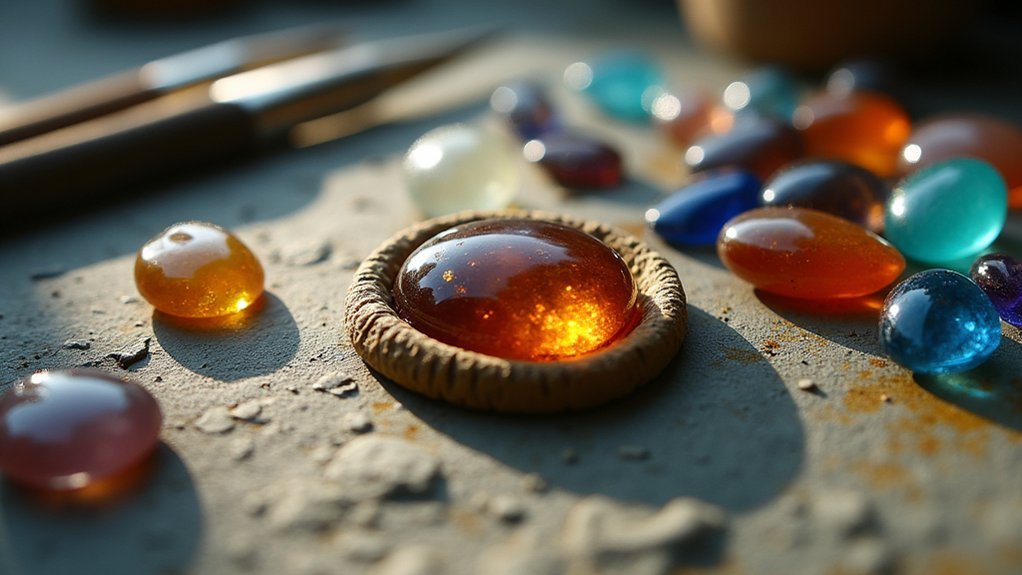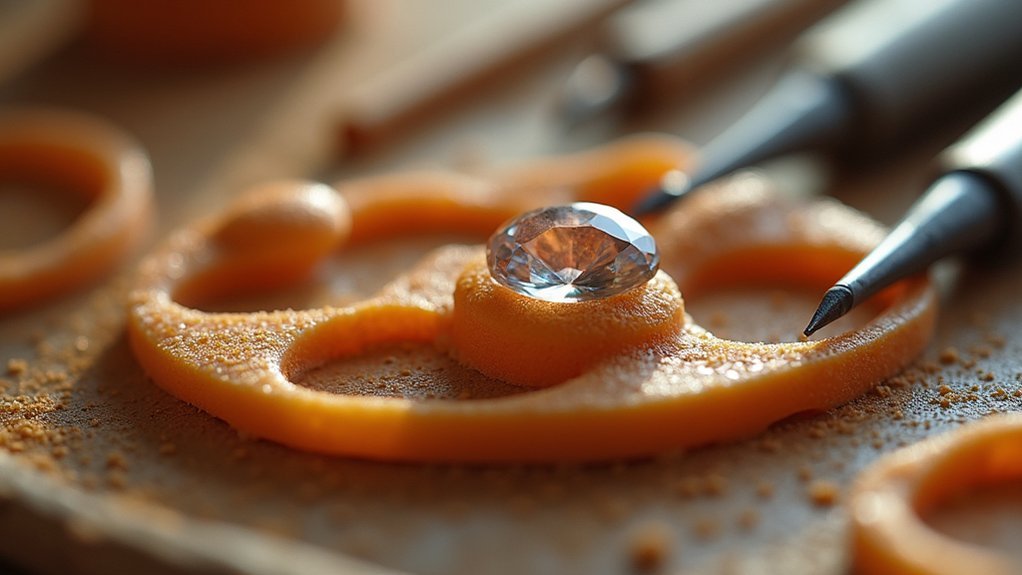You’ll master three essential stone setting techniques for wax casting: bezel settings for cabochons, prong/basket settings for faceted gemstones, and channel settings for multiple stones. For bezel settings, build a protective wax frame that rises slightly above your cabochon’s surface. With prong and basket settings, create precise bearing-cuts using a heated wax pen and guarantee measurements are slightly smaller than the girdle. Channel settings require carved precise dimensions with supportive notches. Maintaining cleanliness throughout prevents contamination that affects metal adhesion, and temperature control protects your valuable gemstones during the casting process for professional results.
Bezel Setting Techniques in Wax for Cabochon Stones

When creating a bezel setting in wax for cabochon stones, you’ll fundamentally build a protective frame that secures your stone during the casting process. Shape your wax models to match the cabochon stone’s exact dimensions, guaranteeing the bezel edge rises slightly above the stone’s surface.
Maintain cleanliness throughout this process, as contamination affects metal adhesion during casting. Use a heated wax pen to secure the stone in place by gently melting surrounding wax, allowing it to grip the stone’s edges without force.
Monitor temperature carefully to prevent stone damage and guarantee proper hardening around pavilion facets. This bezel setting technique creates reliable wax models that translate into professional casting results, making it essential among fundamental casting techniques.
Prong and Basket Setting Methods for Faceted Gemstones
While bezel settings excel with cabochon stones, faceted gemstones demand different approaches that maximize light transmission and showcase the stone’s cut.
Prong settings secure your faceted stones using metal claws that grip the girdle, allowing maximum brilliance while maintaining security. During wax setting, you’ll create precise bearing-cuts using a heated wax pen, aligning with the stone’s facets to prevent excessive pressure.
Prong settings use metal claws to grip faceted stones at the girdle, maximizing brilliance through precise wax bearing-cuts aligned with facets.
Basket setting offers an elegant alternative, supporting your stone from below with thin metal framework.
Both methods require accurate measurements—your setting dimensions must be slightly smaller than the stone’s girdle for proper fit.
Throughout the wax preparation process, maintain cleanliness to prevent contamination that could compromise your casting results.
These techniques guarantee your faceted stones display ideal light performance in the final piece.
Channel Setting Preparation and Stone Placement in Wax Models

Channel settings create continuous rows of stones with no metal visible between them, requiring meticulous preparation in your wax model to achieve professional results.
During the channel setting process, you’ll need to carve precise dimensions slightly smaller than your stones’ girdles for secure placement. Create notches in the wax channel to provide additional support during casting.
Clean your stones thoroughly before stone placement to prevent wax contamination. Use your heated wax pen carefully around the stones, melting surrounding wax without direct contact. Let the melted wax grab the pavilion facets naturally.
Maintain critical temperature control throughout this process to protect high-quality gemstones.
After your casting has been done and excess wax is burnt away, proper preparation minimizes finishing work and reduces materials fee costs considerably.
Frequently Asked Questions
How Do You Set Stones in Wax for Casting?
You’ll heat your wax-pen to controlled temperature, clean stones thoroughly, position them at 45 degrees, and apply molten wax around pavilion facets. Remove the pen immediately when you see liquid wax forming secure bearings.
What Are the Six Steps of the Lost Wax Method of Casting?
You’ll create a wax model, attach sprues, encase in investment plaster, burn out the wax, pour molten metal into the cavity, then cool and remove investment to reveal your finished cast piece.
How Do You Smooth Wax for Casting?
You’ll start with coarse files, then progress to finer grits for sanding. Apply heat using a gun or heated pen to melt the surface. Buff with soft cloth for an ultra-smooth finish.
How to Use Wax Stone?
You’ll heat your wax pen to appropriate temperature, position the stone at 45-degrees, then carefully apply melted wax to grab pavilion facets. Use hard stones above 8.5 Mohs scale for best results.
In Summary
You’ve now mastered three essential wax setting techniques that’ll elevate your casting projects. Remember, bezel settings offer security for cabochons, while prongs showcase faceted stones brilliantly. Channel settings create sleek, continuous lines perfect for multiple stones. Practice each method to understand how wax behaves during carving and fitting. Don’t rush the process—precise wax work translates directly to successful cast pieces. These techniques will become second nature with repetition and patience.





Leave a Reply